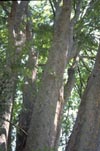Home >
Ulmus chinensis Allee™, Allee Elm
Chinese Elm will grow in full sun on a wide range of soils, adapting easily to extremes in pH and tolerates urban heat and wind. Trees will look their best, though, when grown in moist, well-drained, fertile soil but they adapt to drought and the extremes of urban sites. Very suitable for street tree pits, parking lot islands, and other confined soil spaces. 'Drake' Chinese elms have a reputation of requiring regular pruning due to drooping branches. This more upright cultivar should reduce this requirement some. Allee is much easier to maintain a leader in the nursery and in the landscape than 'Drake'. It will have a long service life in urban areas with proper training early on. The bark is outstanding on Allee.
The parent plant 'Emer II' (trademarked as Allee) (PP #7552) has four ascending stems originating about 12 feet from the ground and is about 75 feet tall and nearly as wide. This is similar to the proportions on American elm. The bark is wonderful with irregular fluting forming deep creases from the soil line well up into the canopy. Included bark on the parent tree is not as bad as on the parent tree of 'Emer I' (Athena) elm. This elm has stood the test called time, it has been through at least one severe ice storm in the last 10 years, and should make a great addition to the urban tree palette. I see it used best along streets forming an overhead canopy similar to that created by American elm. Once it becomes widely available, please do not use it everywhere - lets not wear out this wonderful tree. Diversity is the key to sustainability.
Growers should train this tree, and you should purchase it, with one dominant leader well up into the canopy. Allee reportedly grows faster and has a finer root system than Athena. Allee may be easier to train to a dominant trunk.
Roots generate sprouts when they are cut. Sometimes trees appear in landscapes because mulch made from Chinese elm roots is used at the site. Elms that are root pruned a few weeks before hand can be dug from a field nursery in summer without any problems provided irrigation is applied regularly after root pruning and digging. Chinese elm is typically rooted on its own roots due to graft incompatibility problems with budding and grafting. Chinese elms reportedly produce highly allergenic pollen.
Elms
are among those susceptible to summer branch drop according to surveys
in California. Summer branch drop is a phenomena resulting in failure
and breakage of large diameter, live branches typically on calm summer
days.



